摘要
自组装是生物大分子结构形成的基础方式之一。酶促自组装(enzyme-instructed self-assembly,EISA)借助工具酶,在特定的部位实现小分子化合物向超分子纳米结构的转换,成为药物开发的全新策略。近年来,EISA在恶性肿瘤的治疗和成像领域取得了长足的进步,实现了纳米结构的精确调控和肿瘤靶向。本文综述了EISA在肿瘤诊疗领域的最新进展,工具酶如碱性磷酸酶、去乙酰化酶、酪氨酸酶、γ-谷氨酰转肽酶和胱天蛋白酶3等的作用与特点,总结了在肿瘤治疗中EISA靶向多种细胞器的研究现状,并介绍了EISA在肿瘤成像中的运用,为EISA策略在肿瘤诊疗中的应用研究提供参考。
自组装是单体在无干预的情况下,从游离的、无规律分布的状态,借助分子间的非共价相互作用(如范德华力、静电力、疏水作用力、氢键和π-π堆积),自发形成具有特定结构的有序状态的过
近年来,采用酶促自组装(enzyme-instructed self-assembly,EISA)策略,在特异性酶的催化下,小分子化合物在肿瘤中形成超分子纳米结构的研究取得了重要进
EISA在肿瘤的治疗和分子成像等领域存在巨大的研究和临床价
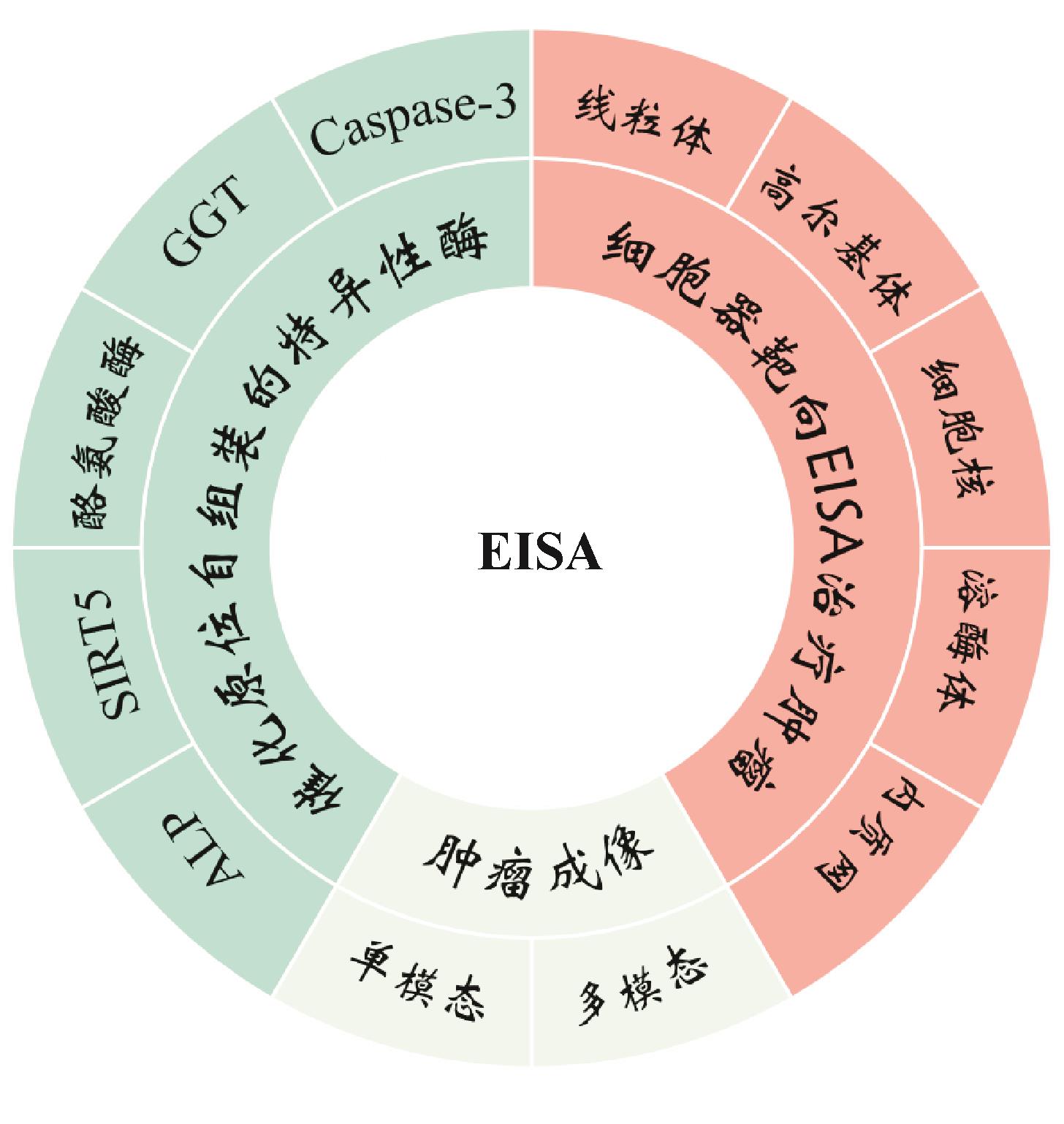
图1 酶促自组装(EISA)在肿瘤治疗和成像中的应用
ALP:碱性磷酸酶;SIRT5:去乙酰化酶;GGT:γ-谷氨酰转肽酶
EISA采用具有适度水溶性的小分子化合物,在到达肿瘤部位后,经肿瘤细胞高表达的酶识别,催化小分子转化为亲脂亲水两亲性分子,从而改变分子间的非共价相互作用,激发自组装过程形成纳米结
自从2004年,Yang
作为多肽折叠和蛋白质活性的常用调节开关,磷酸化与去磷酸化已被用来控制超分子纳米结构的转
磷酸化位点影响ALP的水解活性,Chen

图2 ALP酶促自组装的底物结构
除了小分子直接作为自组装的模块,ALP也可以催化纳米结构的去磷酸化,调节其自组装形成更复杂的纳米结构。He
尽管对ALP的底物研究主要集中在含有磷酸酪氨酸的小分子上,但是磷酸丝氨酸、磷酸苏氨酸的潜在应用也不可忽
蛋白质中赖氨酸残基可以发生多种翻译后修饰,包括琥珀酰化、乙酰化和甲基化,而赖氨酸在蛋白质折叠过程中十分重要,所以赖氨酸的修饰会影响蛋白质的结构和功
Yang

图3 SIRT5酶促自组装的底物结构
酪氨酸酶是一种含铜氧化酶,可以使单酚(酪氨酸)氧化生成邻二酚(多巴),后者可进一步氧化生成多巴醌,这是黑色素的前体,广泛存在于动植物
依据酪氨酸酶催化的底物结构,Sun
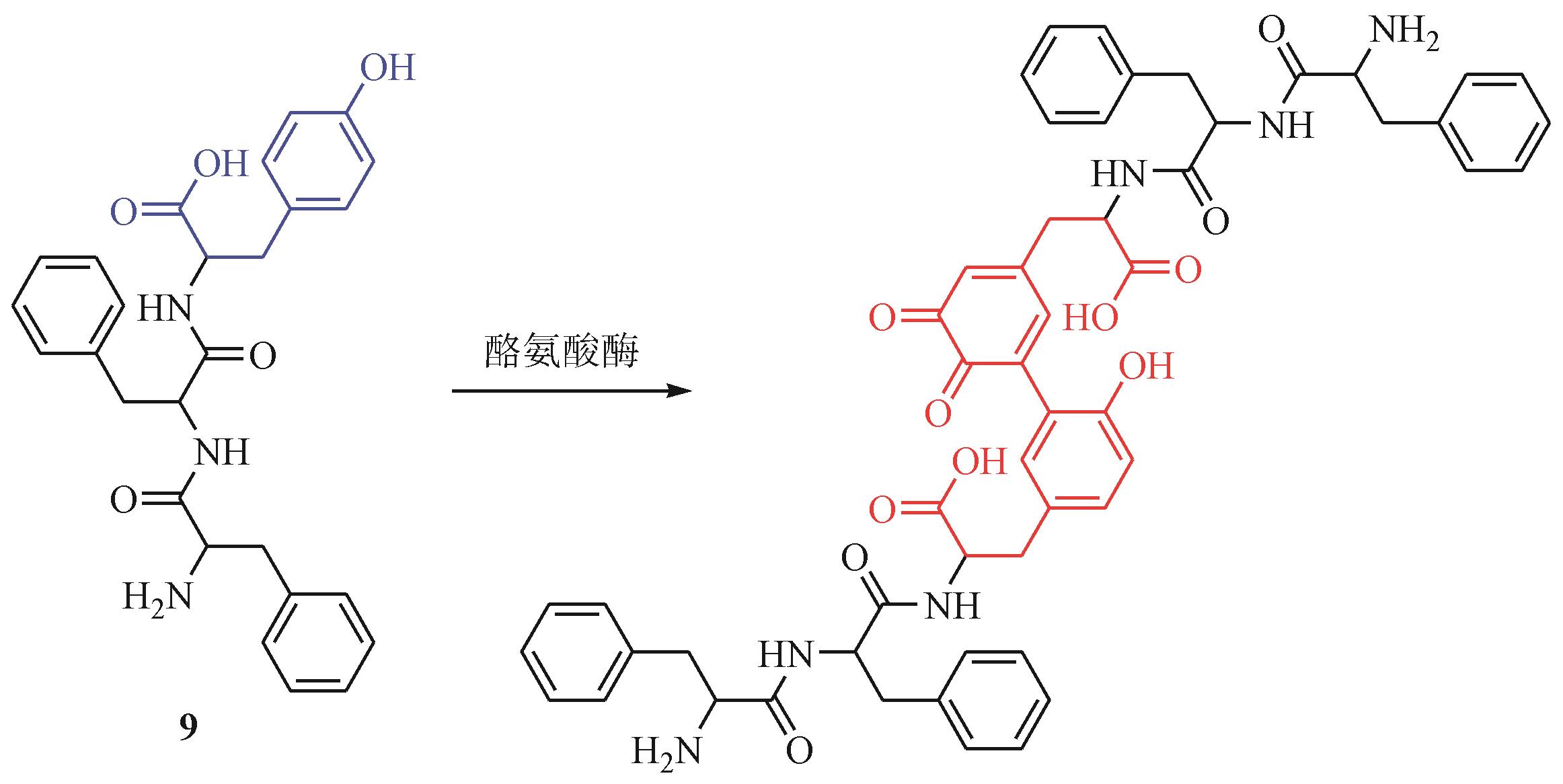
图4 酪氨酸酶催化底物氧化生成二聚体的结构和反应示意图
γ-谷氨酰转肽酶(γ-glutamyl transpeptidase,GGT)是一种细胞膜结合酶,可以催化γ-谷氨酰基的裂
Ye

图5 GGT与谷胱甘肽参与的点击缩合反应示意图
胱天蛋白酶(caspase)家族被发现与细胞凋亡进程的启动和执行密切相关,caspase-3是细胞凋亡执行酶(executioner caspases)的一种。通过特异性地切割天冬氨酸和半胱氨酸之间的肽键,破坏不同结构和功能的蛋白质而导致不可逆转的细胞凋
Wang

图6 Caspase-3和谷胱甘肽(GSH)参与的点击缩合反应
在EISA中使用的酶种还包括弗林蛋白
细胞器在细胞的各项生命活动中起主导作用,靶向性破坏肿瘤细胞器的功能,可以提高对肿瘤尤其是耐药肿瘤的治疗效
三苯基膦(triphenylphosphinium,TPP)阳离子可以在较高的线粒体膜电位驱动下,实现线粒体积累,是一种靶向线粒体的功能基
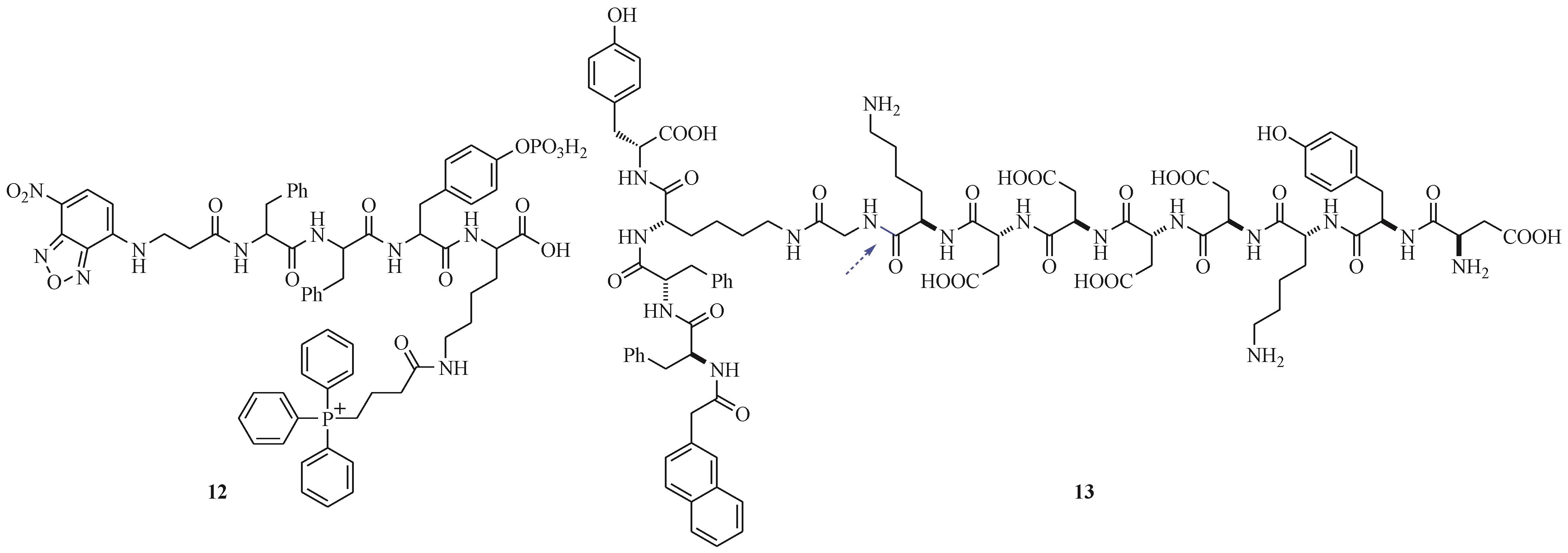
图7 线粒体靶向的化合物结构
肠激酶(enterokinase,ENTK)存在于HeLa细胞线粒
破坏细胞高尔基体的功能将严重影响蛋白质的合成,翻译后修饰和运输。Tan

图8 高尔基体靶向的化合物结构
尽管HepG2细胞也过表达ALP,但是胞内过量的GSH会干扰高尔基体中CRPs的捕获。Tan
细胞核是重要的细胞器,许多化疗药物的作用靶点位于细胞核,如喜树碱类抗肿瘤药物的靶标拓扑异构酶Ⅰ。由于进入细胞核的药量少,削弱了其抗肿瘤活
Liu
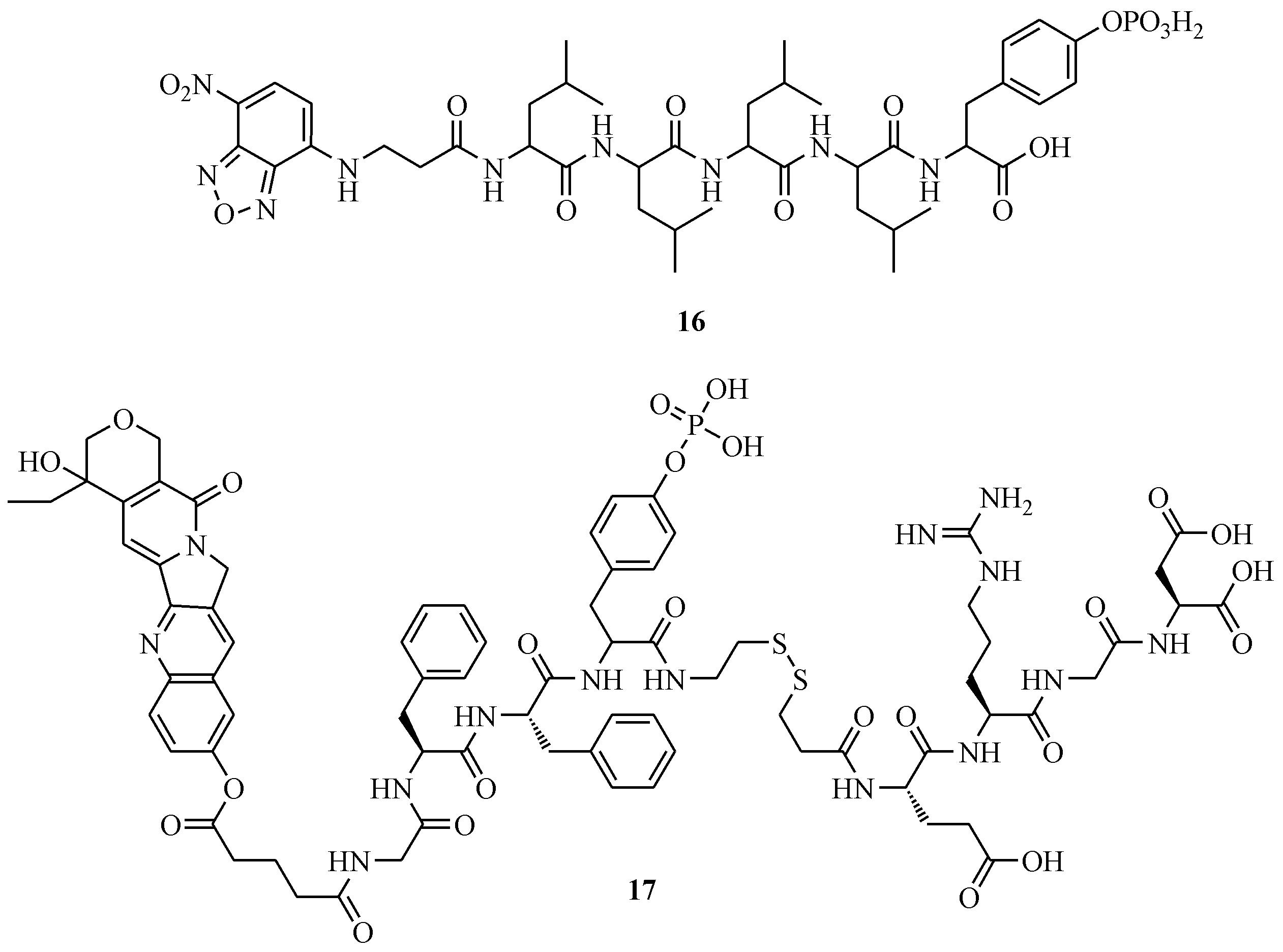
图9 细胞核靶向的化合物结构
Zhan
溶酶体是细胞内外物质降解与循环的重要细胞器,其酸性的内部环境为多种水解酶参与内吞、自噬和细胞凋亡等过程提供了支
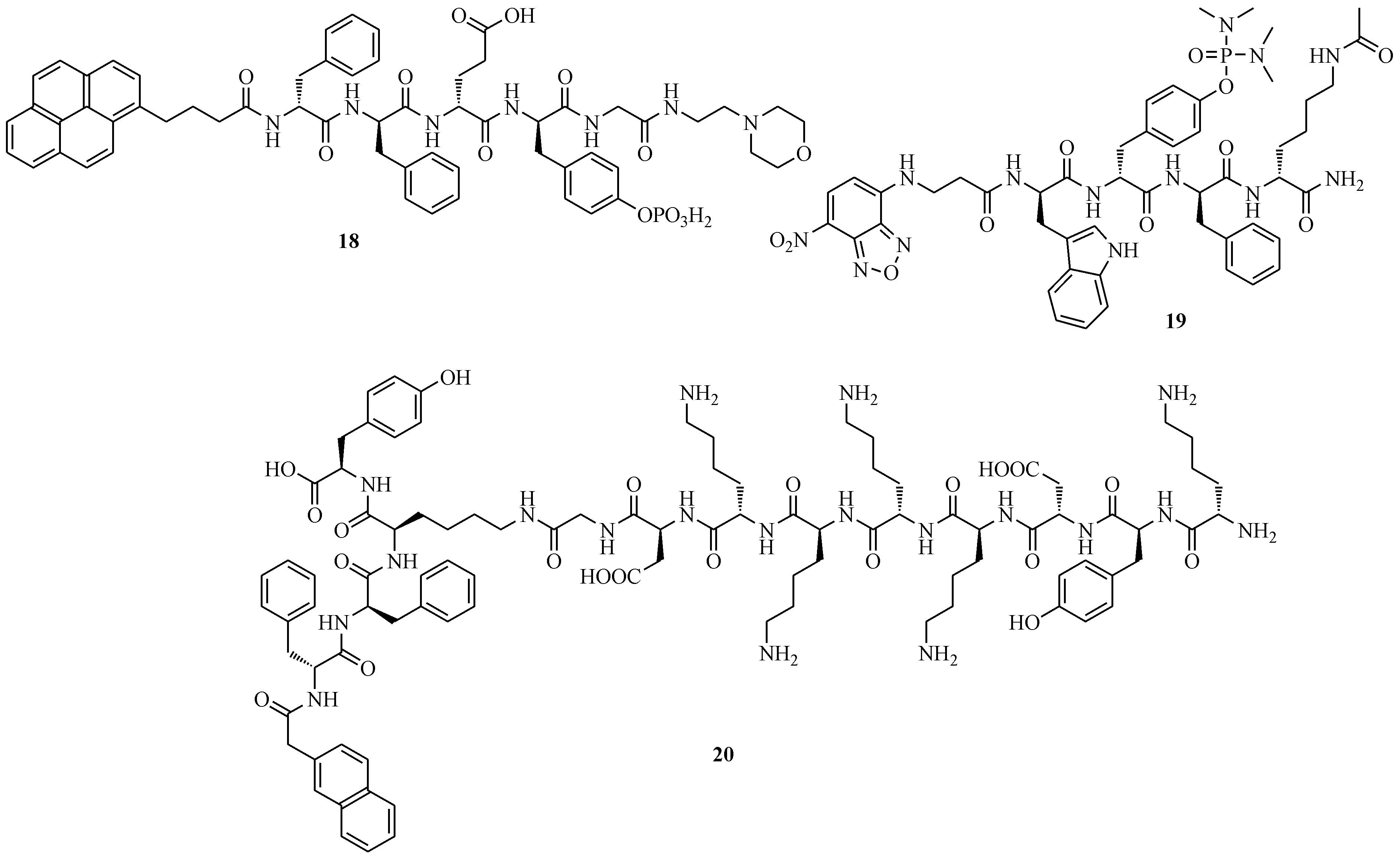
图10 其他细胞器靶向的化合物结构
内质网参与生物体脂质的合成,大多数蛋白质的折叠和修饰,干扰内质网稳态可能会引起程序性细胞死
由于非侵入性和可视化的特点,分子成像技术已经成为研究生物分子变化过程的通用工具,同时也是肿瘤早期诊断的重要手
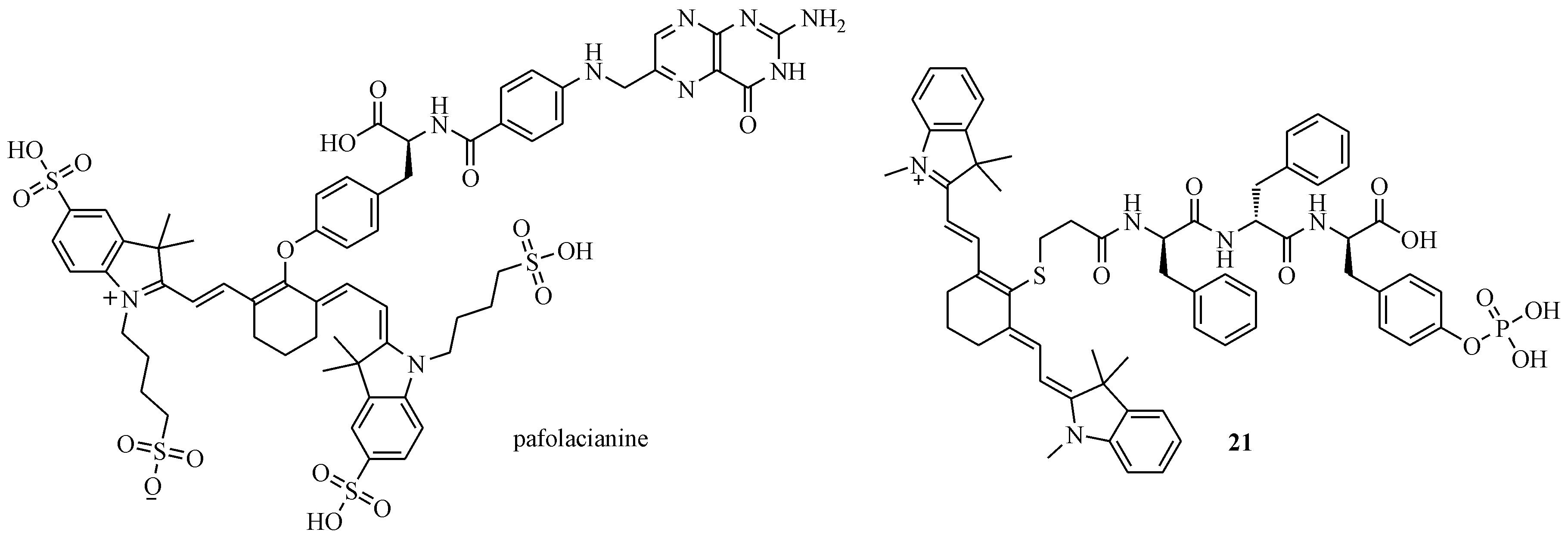
图11 分子成像探针结构
近年来,EISA技术在分子成像领域的应用引起了越来越多的关注。Wu
最近,Ye课题组发表了一系列将EISA应用在肿瘤多模态成像领域的创新性研究工作,为肿瘤的早期诊断带来了新的思路与方
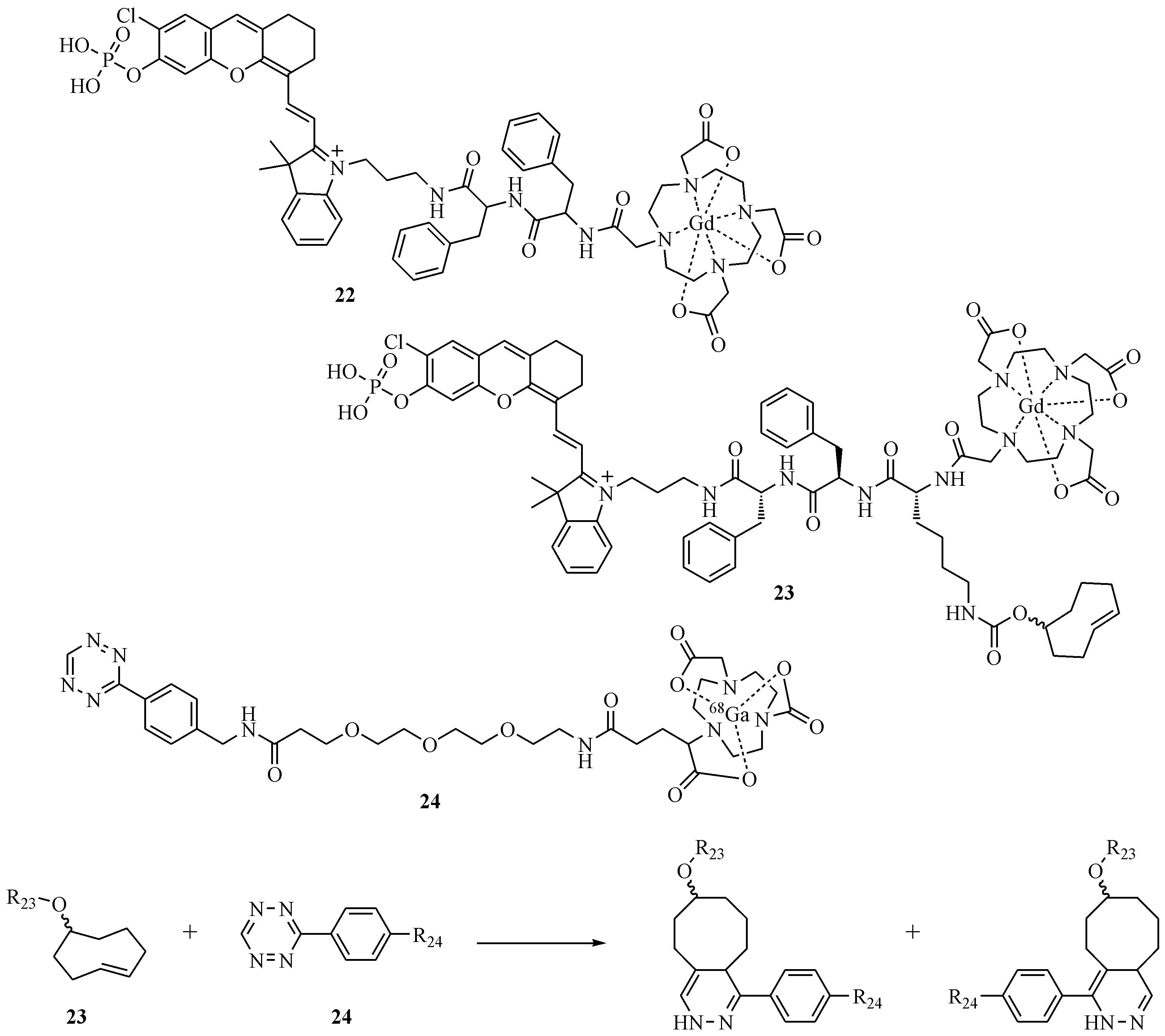
图12 多模态成像探针结构以及逆电子需求的狄尔斯-阿尔德(IEDDA)反应示意图
随着逆电子需求的狄尔斯-阿尔德(inverse electron demand Diels-Alder,IEDDA)反应在分子成像领域的应
| 化合物 | 特异性酶 | 临界聚集/ 胶束浓度 | 酶促前纳米性质 | 酶促后纳米性质 | EISA作用 |
|---|---|---|---|---|---|
| 1 | ALP | 2 585.4 μmol/L | 无定形 | α-螺旋的直径7 nm纳米纤维 | - |
| 2 | ALP | 1 538.3 μmol/L | 无定形 | β-折叠的直径11 ~ 23 nm纳米纤维 | - |
| 3 | ALP | 1 381.6 μmol/L | 短纤维 | β-折叠的直径6 nm纳米纤维 | - |
| 5 | ALP | 159 μmol/L | 直径(22.4 ± 7.2) nm纳米颗粒 | 直径(21.9 ± 3.7) nm纳米纤维 | 促进内吞与内涵体逃逸 |
| 6 | ALP | - | 无定形 | 直径24 nm纳米纤维 | - |
| 7 | SIRT5 | - | 无定形 | 直径10 ~ 50 nm纳米纤维 | 实现SIRT5的活性荧光成像 |
| 9 | 酪氨酸酶 | - | - | 纳米颗粒 | 抑制微管蛋白组装 |
| 10 | GGT | - | - | 直径142 nm纳米颗粒 | 增加肿瘤蓄积,提高PET信号 |
| 11 | Caspase-3 | - | - | 直径(135 ± 28) nm纳米颗粒 | 增强PA信号 |
| 12 | ALP | - | 直径(8 ± 2) nm纤维 | 直径约100 nm囊泡 | 定位肿瘤细胞 |
| 13 | ENTK | 165 μmol/L | 胶束 | 纳米颗粒逐渐转化为纳米纤维 | 实现线粒体靶向 |
| 14 | ALP | 6.0 μmol/L | 胶束 | 纳米纤维 | 实现高尔基体靶向 |
| 16 | ALP | 83.3 μmol/L | 纳米颗粒 | 直径(85 ± 13) nm纳米带 | 实现细胞核靶向 |
| 17 | ALP | 91.7 μmol/L | 无定形 | 直径50 ~ 100 nm纳米颗粒 | 定位肿瘤细胞 |
| 18 | ALP | 19.0 μmol/L | - | 直径(74.6 ± 11.6) nm纳米纤维 | 定位肿瘤细胞 |
| 19 | ACP | - | - | 直径6.7 nm纳米纤维 | 靶向溶酶体 |
| 20 | 胰蛋白酶-1 | 194 μmol/L | 直径(15 ± 2) nm胶束 | 直径(8 ± 1) nm纳米纤维 | 靶向内质网 |
| 21 | ALP | 16.0 μmol/L | - | 直径(39.4 ± 5.0) nm纳米颗粒 | 增强PA信号 |
| 22 | ALP | - | - | 直径约66 nm纳米颗粒 | 激活NIRF,增加肿瘤蓄积 |
| 23 | ALP | - | - | 直径约52 nm纳米颗粒 | 激活NIRF,增加肿瘤蓄积 |
| 24 | ALP | - | - | 直径约250 nm纳米颗粒 | 激活NIRF,增加肿瘤蓄积 |
ENTK:肠激酶;PET:正电子发射断层扫描;PA:光声;NIRF:近红外荧光成像
虽然近几年来EISA取得了长足的进步,但是仍然有些难题亟待解决。(1)可供选择的酶种类较少。借助肿瘤中高表达的酶,小分子化合物可以自组装形成纳米结构,增大在肿瘤中的积累,但是一种酶促策略难以适用于多种肿瘤细胞,而且正常组织中的酶活性会干扰小分子的原位自组装,因此寻找肿瘤,甚至其他疾病特异性的酶将极大促进EISA的发展。(2)给药剂量大,抗癌效率较低。多数研究中的给药剂量仍然处于微摩尔级别,抗癌效率较低,这与小分子较高的CAC相关,未来对小分子自组装能力的优化,将会减少带给人体生命健康造成的隐患。伴随着对EISA的深入研究,其在肿瘤治疗和成像方面的前景广阔。EISA靶向细胞器,走进亚细胞单位,对自组装实现精确调控,引发细胞器功能障碍,减少耐药性的发生,为肿瘤的治疗带来新的策略。EISA可以实现成像信号“关-开”的控制,延长成像时间,为肿瘤的成像提供新的思路。期待EISA技术能够为肿瘤的诊断和治疗发展带来更多可能。
References
Whitesides GM, Grzybowski B. Self-assembly at all scales[J]. Science, 2002, 295(5564): 2418-2421. [百度学术]
Whitesides GM, Mathias JP, Seto CT. Molecular self-assembly and nanochemistry: a chemical strategy for the synthesis of nanostructures[J]. Science, 1991, 254(5036): 1312-1319. [百度学术]
Dergham M, Lin SM, Geng J. Supramolecular self-assembly in living cells[J]. Angew Chem Int Ed Engl, 2022, 61(18): e202114267. [百度学术]
Sagalowicz L, Michel M, Blank I, et al. Self-assembly in food—a concept for structure formation inspired by nature[J]. Curr Opin Colloid Interface Sci, 2017, 28: 87-95. [百度学术]
Müller MM, Muir TW. Histones: at the crossroads of peptide and protein chemistry[J]. Chem Rev, 2015, 115(6): 2296-2349. [百度学术]
Bugyi B, Carlier MF. Control of actin filament treadmilling in cell motility[J]. Annu Rev Biophys, 2010, 39: 449-470. [百度学术]
Wang YQ, Bai H, Miao YX, et al. Tailoring a near-infrared macrocyclization scaffold allows the control of in situ self-assembly for photoacoustic/PET bimodal imaging[J]. Angew Chem Int Ed Engl, 2022, 61(14): e202200369. [百度学术]
Wang ZX, Guo YR, Xianyu YL. Applications of self-assembly strategies in immunoassays: a review[J]. Coord Chem Rev, 2023, 478: 214974. [百度学术]
Webber MJ, Pashuck ET. (Macro)molecular self-assembly for hydrogel drug delivery[J]. Adv Drug Deliv Rev, 2021, 172: 275-295. [百度学术]
Yi MH, Guo JQ, He HJ, et al. Phosphobisaromatic motifs enable rapid enzymatic self-assembly and hydrogelation of short peptides[J]. Soft Matter, 2021, 17(38): 8590-8594. [百度学术]
Vendruscolo M, Dobson CM. Structural biology. Dynamic visions of enzymatic reactions[J]. Science, 2006, 313(5793): 1586-1587. [百度学术]
Zhan J, Wang YH, Ma SD, et al. Organelle-inspired supramolecular nanomedicine to precisely abolish liver tumor growth and metastasis[J]. Bioact Mater, 2022, 9: 120-133. [百度学术]
Wu CF, Zhang R, Du W, et al. Alkaline phosphatase-triggered self-assembly of near-infrared nanoparticles for the enhanced photoacoustic imaging of tumors[J]. Nano Lett, 2018, 18(12): 7749-7754. [百度学术]
Kim BJ, Xu B. Enzyme-instructed self-assembly for cancer therapy and imaging[J]. Bioconjug Chem, 2020, 31(3): 492-500. [百度学术]
Wang DY, Hu YX, Ye PD. Activatable multimodal probes for in vivo imaging and theranostics[J]. Angew Chem Int Ed, 2022, 61(50): e202209512. [百度学术]
Biswas S, Torchilin VP. Nanopreparations for organelle-specific delivery in cancer[J]. Adv Drug Deliv Rev, 2014, 66: 26-41. [百度学术]
He HJ, Tan WY, Guo JQ, et al. Enzymatic noncovalent synthesis[J]. Chem Rev, 2020, 120(18): 9994-10078. [百度学术]
Wang JY, Li H, Xu B. Biological functions of supramolecular assemblies of small molecules in cellular environment[J]. RSC Chem Biol, 2021, 2(2): 289-305. [百度学术]
Yang Z, Gu H, Fu D, et al. Enzymatic formation of supramolecular hydrogels[J]. Adv Mater, 2004, 16(16): 1440-1444. [百度学术]
Chen YX, Zhang WW, Ding YH, et al. Preorganization boosts the artificial esterase activity of a self-assembling peptide[J]. Sci China Chem, 2021, 64(9): 1554-1559. [百度学术]
He HJ, Guo JQ, Xu JS, et al. Dynamic continuum of nanoscale peptide assemblies facilitates endocytosis and endosomal escape[J]. Nano Lett, 2021, 21(9): 4078-4085. [百度学术]
Zhou J, Du XW, Wang JQ, et al. Enzyme-instructed self-assembly of peptides containing phosphoserine to form supramolecular hydrogels as potential soft biomaterials[J]. Front Chem Sci Eng, 2017, 11(4): 509-515. [百度学术]
Yang L, Peltier R, Zhang MM, et al.Desuccinylation-triggered peptide self-assembly: live cell imaging of SIRT5 activity and mitochondrial activity modulation[J]. J Am Chem Soc, 2020, 142(42): 18150-18159. [百度学术]
Houtkooper RH, Pirinen E, Auwerx J. Sirtuins as regulators of metabolism and healthspan[J]. Nat Rev Mol Cell Biol, 2012, 13(4): 225-238. [百度学术]
Wang YY, Chen H, Zha XM. Overview of SIRT5 as a potential therapeutic target: structure, function and inhibitors[J]. Eur J Med Chem, 2022, 236: 114363. [百度学术]
Yang X, Wang Z, Li X, et al. SHMT2 desuccinylation by SIRT5 drives cancer cell proliferation[J]. Cancer Res, 2018, 78(2): 372-386. [百度学术]
Taylor SW. Chemoenzymatic synthesis of peptidyl 3, 4-dihydroxyphenylalanine for structure-activity relationships in marine invertebrate polypeptides[J]. Anal Biochem, 2002, 302(1): 70-74. [百度学术]
Lai XL, Wichers HJ, Soler-Lopez M, et al. Structure and function of human tyrosinase and tyrosinase-related proteins[J]. Chemistry, 2018, 24(1): 47-55. [百度学术]
Choi YS, Yang YJ, Yang B, et al. In vivo modification of tyrosine residues in recombinant mussel adhesive protein by tyrosinase co-expression in Escherichia coli[J]. Microb Cell Fact, 2012, 11: 139. [百度学术]
Sun M, Wang CY, Lv MC, et al. Intracellular self-assembly of peptides to induce apoptosis against drug-resistant melanoma[J]. J Am Chem Soc, 2022, 144(16): 7337-7345. [百度学术]
Tate SS, Meister A. Interaction of gamma-glutamyl transpeptidase with amino acids, dipeptides, and derivatives and analogs of glutathione[J]. J Biol Chem, 1974, 249(23): 7593-7602. [百度学术]
Pompella A, De Tata V, Paolicchi A, et al. Expression of gamma-glutamyltransferase in cancer cells and its significance in drug resistance[J]. Biochem Pharmacol, 2006, 71(3): 231-238. [百度学术]
Hai ZJ, Wu JJ, Wang L, et al. Bioluminescence sensing of γ-glutamyltranspeptidase activity in vitro and in vivo[J]. Anal Chem, 2017, 89(13): 7017-7021. [百度学术]
Obara R, Kamiya M, Tanaka Y, et al. γ-glutamyltranspeptidase (GGT)-activatable fluorescence probe for durable tumor imaging[J]. Angew Chem Int Ed Engl, 2021, 60(4): 2125-2129. [百度学术]
Ye SQ, Wang SJ, Gao DY, et al. A new γ-glutamyltranspeptidase-based intracellular self-assembly of fluorine-18 labeled probe for enhancing PET imaging in tumors[J]. Bioconjug Chem, 2020, 31(2): 174-181. [百度学术]
Boice A, Bouchier-Hayes L. Targeting apoptotic caspases in cancer[J]. Biochim Biophys Acta Mol Cell Res, 2020, 1867(6): 118688. [百度学术]
Wang YQ, Hu XM, Weng JH, et al. A photoacoustic probe for the imaging of tumor apoptosis by caspase-mediated macrocyclization and self-assembly[J]. Angew Chem Int Ed Engl, 2019, 58(15): 4886-4890. [百度学术]
Li X, Cao CY, Wei P, et al. Self-assembly of amphiphilic peptides for recognizing high furin-expressing cancer cells[J]. ACS Appl Mater Interfaces, 2019, 11(13): 12327-12334. [百度学术]
Kim BJ, Fang Y, He HJ, et al. Trypsin-instructed self-assembly on endoplasmic reticulum for selectively inhibiting cancer cells: dedicated to Professor George M. Whitesides on the occasion of his 80th birthday[J]. Adv Healthc Mater, 2021, 10(4): e2000416. [百度学术]
Saminathan A, Zajac M, Anees P, et al. Organelle-level precision with next-generation targeting technologies[J]. Nat Rev Mater, 2022, 7(5): 355-371. [百度学术]
Zielonka J, Joseph J, Sikora A, et al. Mitochondria-targeted triphenylphosphonium-based compounds: syntheses, mechanisms of action, and therapeutic and diagnostic applications[J]. Chem Rev, 2017, 117(15): 10043-10120. [百度学术]
Wang HM, Feng Z, Wang YZ, et al. Integrating enzymatic self-assembly and mitochondria targeting for selectively killing cancer cells without acquired drug resistance[J]. J Am Chem Soc, 2016, 138(49): 16046-16055. [百度学术]
He HJ, Wang JQ, Wang HM, et al. Enzymatic cleavage of branched peptides for targeting mitochondria[J]. J Am Chem Soc, 2018, 140(4): 1215-1218. [百度学术]
Tan WY, Zhang QX, Wang JQ, et al. Enzymatic assemblies of thiophosphopeptides instantly target Golgi apparatus and selectively kill cancer cells[J]. Angew Chem Int Ed Engl, 2021, 60(23): 12796-12801. [百度学术]
Tan WY, Zhang QX, Quiñones-Frías MC, et al. Enzyme-responsive peptide thioesters for targeting Golgi apparatus[J]. J Am Chem Soc, 2022, 144(15): 6709-6713. [百度学术]
Behera A, Padhi S. Passive and active targeting strategies for the delivery of the camptothecin anticancer drug: a review[J].Environ Chem Lett, 2020, 18(5): 1557-1567. [百度学术]
Pan LM, Liu JN, Shi JL. Cancer cell nucleus-targeting nanocomposites for advanced tumor therapeutics[J]. Chem Soc Rev, 2018, 47(18): 6930-6946. [百度学术]
Liu S, Zhang QX, He HJ, et al. Intranuclear nanoribbons for selective killing of osteosarcoma cells[J]. Angew Chem Int Ed Engl, 2022, 61(44): e202210568. [百度学术]
Liu S, Zhang QX, Shy AN, et al. Enzymatically forming intranuclear peptide assemblies for selectively killing human induced pluripotent stem cells[J]. J Am Chem Soc, 2021, 143(38): 15852-15862. [百度学术]
Bonam SR, Wang FJ, Muller S. Lysosomes as a therapeutic target[J]. Nat Rev Drug Discov, 2019, 18(12): 923-948. [百度学术]
Wu CF, Wang CC, Zhang T, et al. Lysosome-targeted and fluorescence-turned “on” cytotoxicity induced by alkaline phosphatase-triggered self-assembly[J]. Adv Healthc Mater, 2022, 11(1): e2101346. [百度学术]
Yang XJ, Lu HL, Tao YH, et al. Spatiotemporal control over chemical assembly in living cells by integration of acid-catalyzed hydrolysis and enzymatic reactions[J]. Angew Chem Int Ed Engl, 2021, 60(44): 23797-23804. [百度学术]
Shi YY, Wang SJ, Wu JL, et al. Pharmaceutical strategies for endoplasmic reticulum-targeting and their prospects of application[J]. J Control Release, 2021, 329: 337-352. [百度学术]
Zhou ZX, Lu ZR. Molecular imaging of the tumor microenvironment[J]. Adv Drug Deliv Rev, 2017, 113: 24-48. [百度学术]
Dindere ME, Tanca A, Rusu M, et al. Intraoperative tumor detection using pafolacianine[J]. Int J Mol Sci, 2022, 23(21): 12842. [百度学术]
Tanyi JL, Randall LM, Chambers SK, et al. A phase III study of pafolacianine injection (OTL38) for intraoperative imaging of folate receptor-positive ovarian cancer (study 006)[J]. J Clin Oncol, 2023, 41(2): 276-284. [百度学术]
Yan RQ, Hu YX, Liu F, et al. Activatable NIR fluorescence/MRI bimodal probes for in vivo imaging by enzyme-mediated fluorogenic reaction and self-assembly[J]. J Am Chem Soc, 2019, 141(26): 10331-10341. [百度学术]
Hu YX, Miao YX, Zhang JY, et al. Alkaline phosphatase enabled fluorogenic reaction and in situ coassembly of near-infrared and radioactive nanoparticles for in vivo imaging[J]. Nano Lett, 2021, 21(24): 10377-10385. [百度学术]
Hu YX, Zhang JY, Miao YX, et al. Enzyme-mediated in situ self-assembly promotes in vivo bioorthogonal reaction for pretargeted multimodality imaging[J]. Angew Chem Int Ed Engl, 2021, 60(33): 18082-18093. [百度学术]
Chen ZX, Chen M, Zhou KX, et al. Pre-targeted imaging of protease activity through in situ assembly of nanoparticles[J]. Angew Chem Int Ed Engl, 2020, 59(20): 7864-7870. [百度学术]